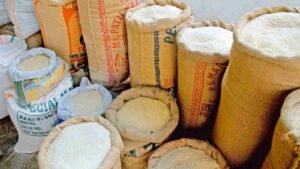The Indian government’s recent decision to prohibit the use of sugarcane juice and sugar syrup for ethanol production in the 2023-24 supply year has stirred discussions within the sugar industry. The directive, issued by the Food Ministry in a letter to Managing Directors and CEOs of all sugar mills and distilleries, aims to ensure an ample supply of sugar for domestic consumption and to stabilize prices. However, this move has sparked both support and concerns within the sugar industry.
Restriction Period on Sugarcane Juice
According to the letter, sugar mills and distilleries are directed “not to use sugarcane juice /sugar syrup” for ethanol production during the December 2023 to November 2024 ethanol supply year. This decision is in line with clauses 4 and 5 of the Sugar (Control) Order 1966. While restricting the use of sugarcane juice, the government has allowed the use of B-heavy molasses for ethanol production in the same period.
Reason For Restrictions
The backdrop of this decision is the anticipated fall in sugar production in the 2023-24 marketing year (October-September). The National Federation of Cooperative Sugar Factories (NFCSF) Managing Director, Pakash P Naiknavare, welcomed the move, stating that there is a substantial stock of ethanol made from B-molasses in the country, addressing the industry’s concerns.
However, there are uncertainties raised by industry stakeholders. Naiknavare highlighted ambiguity in the letter concerning the supply of ethanol from “existing offers” received by Oil Marketing Companies (OMCs) from B-heavy molasses. The question remains whether this supply will be withdrawn after the existing tender is over, and there is a need for clarity on this matter.
Moreover, concerns were raised about units specifically built for making ethanol from sugarcane juice and sugar syrup. If these units remain unoperational due to the restriction, they could face financial challenges, potentially becoming economically unviable.
AISTA on Sugarcane Juice Restriction
The All India Sugar Trade Association (AISTA) Chairman, Praful Vithalani, noted that B-molasses production shall continue against existing offers, but the uncertainty lies in whether it will persist for the next B-molasses tender. He also expressed that OMCs may refrain from issuing new tenders for B-molasses ethanol until the sugar situation becomes clearer.
Effects on Sugar Production
The Indian Sugar Mills Association (ISMA) has projected a 9 per cent fall in gross sugar production at 337 lakh tonnes for the 2023-24 marketing year. However, it has not estimated the diversion of sugar for ethanol production, adding another layer of uncertainty to the industry’s outlook.
This decision comes at a time when India has experienced a significant drop in sugar exports, with 61 lakh tonnes exported during the 2022-23 marketing year compared to a record 112 lakh tonnes in the previous year. The government has yet to allow exports for the current marketing year.
Other Bans Imposed By Government
The government’s decision to curtail the utilization of sugarcane juice for ethanol production is part of a comprehensive strategy to mitigate food inflation. Complementing this move, the Central government has implemented additional measures, including the prohibition of wheat and broken rice exports and the enforcement of a minimum export price (MEP) for basmati rice. These strategic actions showcase a concerted effort to stabilize the domestic food market, emphasizing the administration’s commitment to fostering economic balance and ensuring food security. The multifaceted approach reflects a proactive stance towards addressing various facets of the nation’s agricultural and economic landscape.
Concerns within Sugar Industry
While the government’s decision aims to prioritize domestic sugar availability and stabilize prices, it has raised valid concerns within the sugar industry. Clarity on the continuity of ethanol supply from B-heavy molasses and the fate of units designed for sugarcane juice and sugar syrup ethanol production is crucial for the industry’s future. As the 2023-24 marketing year unfolds, stakeholders eagerly await further developments and potential revisions to ensure a balanced approach to both sugar and ethanol production in India.












Comments 1